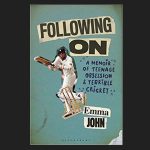We own a periodic table. Mostly it’s a footrest, but periodically – typically when we have visitors – it reverts to being a table. Apparently there’s another kind of periodic table too which lays out all the chemical elements according to atomic number and whatnot.
The Periodic Table of Cricket attempts to do something similar with cricketers. John Stern, the former editor of The Wisden Cricketer and current editor-at-large at All Out Cricket, has tried to put all of the most significant cricketers into groups and then slotted it all together to create a rather nice pull-out poster thing on the inside cover.
The main categories are:
- Defenders and pragmatists
- Stylists and entertainers
- Mavericks and rebels
- Innovators and pioneers
Needless to say, not everyone easily fits into one category and some players might have suited different parts of the table at different stages of their career, but Stern cheerfully admits that there’s occasionally a touch of forceful shoving into a given pigeonhole. That’s half the point. The table is a great place to start if you fancy a pointless cricket argument with someone – and who doesn’t enjoy a pointless cricket argument?
The meat of the book comprises profiles of each of the players. In length and tone, they’re not unlike the ones you see on Cricinfo player pages. You probably wouldn’t sit and read a whole series of such things ordinarily, but we found the fact that they’re organised according to style of play rather helpful in this regard. It can be hard to get a feel for players from the distant past, but seeing someone as part of a lineage of obdurate openers or Fancy Dan middle-order stylists helps commit them to memory.
You could probably predict most of the players who have been included, but the innovators and pioneers section in particular allows for the inclusion of more leftfield names such as Mohammad Nabi and Bernard Bosanquet.
The Periodic Table of Cricket isn’t really a book you’d sit down and read cover to cover, but we rather suspect it is one with a long lifespan. At any mention of a largely unfamiliar great player from yesteryear, you can have a quick check and get a feel for who they were. The profiles tend to tick off all the major aspects of a player’s career but the text isn’t dry. The Ricky Ponting pull shot is described with reference to his “thick, hairy forearms” for example.
Think of it as a kind of great player reference guide with the periodic table thing an oddly helpful way of slotting cricketers into your memory. You can buy The Periodic Table of Cricket from Amazon.




I am particularly impressed by Amazon’s pricing policy on this one:
“Buy New: £9.98
RRP: £9.99
You Save: £0.01
FREE Delivery in the UK on orders with at least £10 of books.”
If Amazon really wanted to help out financially they would charge a penny more than the RRP to tip the book into FREE Delivery.
The face of Cricket Captain 2016 in the side ad is Chris Rogers. Hardly the Lionel Messi of cricket.
Does Chris Rogers technically count as an “international cricket captain”?
Ohhh, I see the word “international” appears not to form part of the title anymore. Think that changes the calculus here.
Also intriguing is the “customers who bought this also bought” section.
Rather unimaginatively, The Periodic Table of Cricket hardback twins with The Periodic Table of Football, which came out the same day, in May…
…whereas for the hardback version of my book, The Price of Fish, pride of place goes to a book named “Think Like a Freak”. I really like that.
I wish John Stern (and also Nick “didn’t know he also did football” Holt) good luck with their books and their relationship with Ebury Press. That imprint’s reputation amongst my cohort suggests that it might be easier to do well FOR Ebury than it is to do well BY them.
Is there much overlap amongst those who bought this book and those who own the Modern Toss Periodic Table of Swearing?
I imagine that many a periodic table has caused swearing via the medium of toe-stubbing.